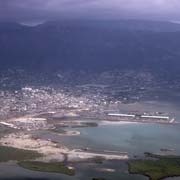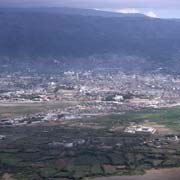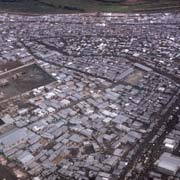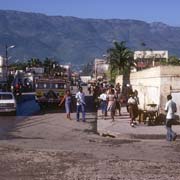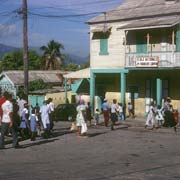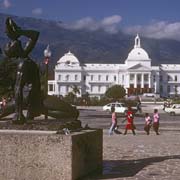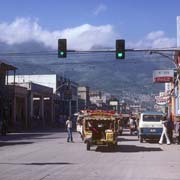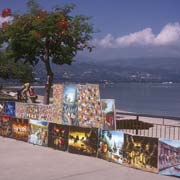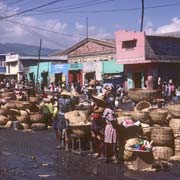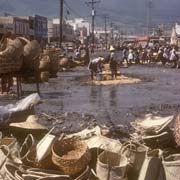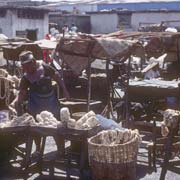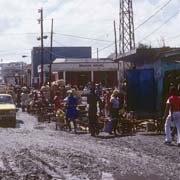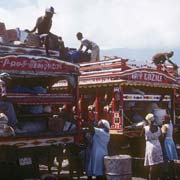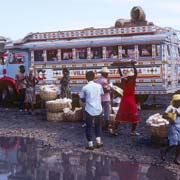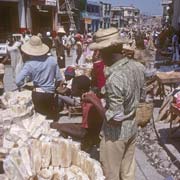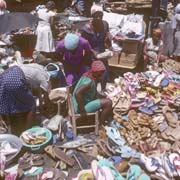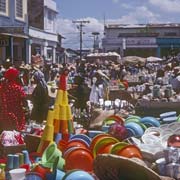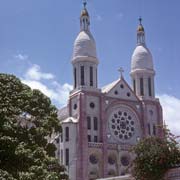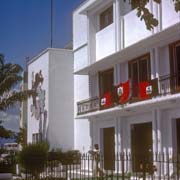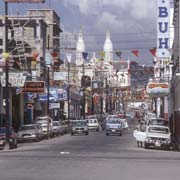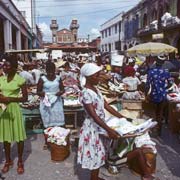Photos of Port-au-Prince, the capital of Haiti
Port-au-Prince, Haiti’s capital
Port-au-Prince is the capital and largest city of Haiti, with between 2.5 and 3 million people. The majority of the population is of African descent, but a prominent mulatto minority controls many of the city’s businesses. There are sizeable numbers of Hispanic residents, as well as small numbers of mostly foreign-born Europeans. Citizens of Middle Eastern ancestry, mainly Syrian and Lebanese, are a growing minority with a significant presence in the capital; most are concentrated in financial areas where most of them establish businesses.
you may then send it as a postcard if you wish.
In the ancient past, the area that would become Port-au-Prince was not the site of any permanent human settlement but a hunting ground: people didn’t live on the coast for fear of raids by the Carib Indians who lived on neighbouring islands. Late 15th Century, the region was controlled by Bohechio, the Taíno cacique (chief) of the chiefdom of Xaragua. Bohechio, childless at death, was succeeded by his sister, Anacaona, who tried to maintain cordial relations with the Spaniards who had arrived. However, they demanded larger and larger tributes, and in 1503, Nicolas Ovando, then governor, set about to end the régime headed by Anacaona. He invited her and other tribal leaders to a feast, and when the Amerindians had drunk a good deal of wine, he ordered most of the guests killed. Anacaona was spared, only to be hanged publicly sometime later.
Through violence and disease, the Spanish settlers decimated the native population. Ovando founded a settlement not far from the coast (west of Etang Saumâtre), named Santa Maria de la Paz Verdadera; it was abandoned several years later. Not long after that, Ovando founded Santa Maria del Puerto, burned by French explorers in 1535, then again in 1592 by the English; the Spanish decided to abandon the region in 1606. In the 17th Century, buccaneers used it as a base, and around 1650, French pirates established a colony at Trou-Borded. As the settlement grew, they set up a hospital not far from the coast, and the region became known as Hôpital. The Spanish tried to retake it but failed, and in 1697 the Treaty of Ryswick was signed in which they renounced any claims to Hôpital. The French then founded bases around the area, including Léogâne, where the old chiefdom of Xaragua had been. The location of Hôpital, the region that was later to contain Port-au-Prince, was inhabited mainly by “flibustiers”, French pirates and in 1707. Under the pressure of the French governor, they closed the hospital, and many became settled farmers.
In 1706 a captain by the name of de Saint-André sailed into the bay just below the hospital, in a ship named Le Prince. He called the area Port-au-Prince (meaning “Port of the Le Prince”), although the port and the surrounding region continued to be known as Hôpital. The colonial administration decided to build a new capital here to control better the French portion of the island of Santo-Domingo (Hispaniola), and in 1749, created a new city. It replaced Cap-Français (modern Cap-Haïtien) in 1770 as the capital of the colony of Saint-Domingue, and in 1804 became the capital of newly independent Haiti. During the French and Haitian Revolutions, it was known as Port-Républicain before Jacques I, Emperor of Haiti, renamed it Port-au-Prince. When Haiti was divided between a kingdom in the north and a republic in the south, Port-au-Prince was the Republic’s capital, under Alexandre Pétion. Henri Christophe renamed the city Port-aux-Crimes after the assassination of Emperor Jacques I at Pont Larnage (now known as Pont-Rouge, and located north of the city).
Port-au-Prince now is a large sprawling city with the majority of its poorer inhabitants concentrated in densely populated slums such as La Saline, located directly north of downtown and west of the middle-class Delmas neighbourhood, Bel-Air, Martissant, and the poorest, most-dangerous slum, Cité Soleil. There are, however also many comfortable living quarters in the city, especially in the southeastern portion of the town around the School of Sacred Heart (École du Sacré-Cœur), and going towards the wealthy upper-class suburb of Pétionville, on the hills overlooking Port-au-Prince from the southeast.
On 12 January 2010, a massive earthquake measuring 7.0 on the Richter scale struck about 15 kilometres southwest of Port-au-Prince, quickly followed by two strong aftershocks of magnitude 5.9 and 5.5. The effects were catastrophic: the death toll was well over 150,000 in Port-au-Prince alone. Most of the central historic area of the city was destroyed, including Haiti’s landmark Cathedral of Our Lady of the Assumption, the capital building, Legislative Palace (the parliament building), Palace of Justice (Supreme Court building), several ministerial buildings, and at least one hospital. The second floor of the Presidential Palace collapsed into the first floor, and the domes skewed at a severe tilt. The seaport and airport were both damaged. Reconstruction has been ongoing.




